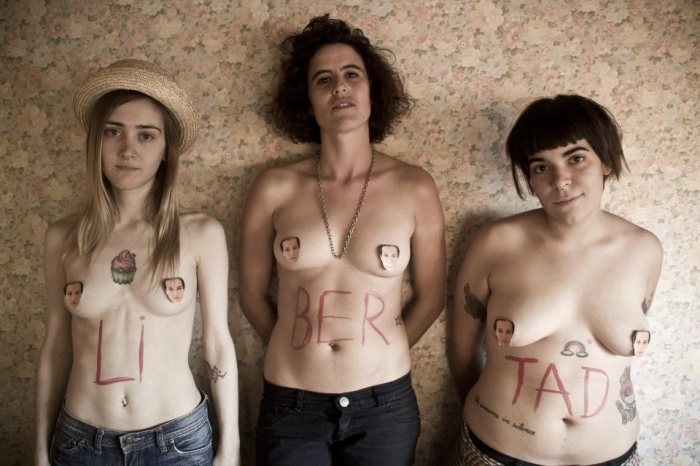Art exists in all forms in every culture. Some would argue, and be right in saying that art is vital to our human nature. It is a part of us and it reflects aspects of our human elements that we cannot necessarily express otherwise. Art is power in the sense that its imagery can be universal and its impact undeniable.
Art is a threat. Art is an opportunity for understanding what is said to be better left misunderstood.
Art liberates and can cause tension where liberation is still in deliberation.
What we can get from art is unmeasurable and unsurmountable. It does not stop providing, and will provide whatever it is the soul is seeking.
Different cultures have felt with the significant social power of art in many different ways. Not every society encourages free expression. This is because the power of social and expressive art is known and feared by those vulnerable to becoming victims of it’s power.
Art can be true without being the truth, it is a spark.
Nudity has held power over structure and status quo since we started wearing cloths in the first place. It is a deliberate and obvious rejection of common civic standards. These young females used their bodies in just this way, writing political statements across their bare bodies, “fuck your morals, my body belongs to me”.
Whether you take it as a youthful outburst of developmental angst and desire to stir the political stew in the form of a spectacle, or as a blatantly honest sentiment being encouraged by trailblazing social liberators, it is art and you saw it, and its cause has been splattered onto world wide media, thus allowing the value of the cause to determine its momentum.
But now they fear for their lives. MORE INFO
Many cases of art persecution deal with disagreeing with authority or criticizing infrastructure or systems. Take Owen Maseko for example, he is mentioned on TIME’S top ten most persecuted artists. He created art exhibiting symbols of government-led massacares to create awareness, and his gallery was closed a day after it opened.
Not only that but he faced time in jail and the possibility of 20 years if fully persecuted. All because it is against the law to speak negatively of the president, even if you suspect him of leading negative initiatives.
Art can offend, that is part of its power.
But we must not reject offensive art but rather ask, why? Why and how can a collection of colors and shapes move us to anger, sadness, horror, or joy. I think we can learn tremendous things about who we are as a being and a species from these types of inquiries and explorations.
If you look at some other names on the list linked above to Time Magazine, you will see some homosexual artists who suffered persecution due to their attempts to expose society to their sexuality through artistic expression.
They were heavily offending an audience who lived by different standards, they perhaps were not wrong in their actions of free expression as no one should be, but the world moves slowly and in their time and place they pushed to far for the audience to keep up.
Remember, there is no fear in true art. There is no room for it, art must be something that allows itself to be vulnerable in order to elicit an honest response. If art is honest with the viewer than it is up to the viewer to decide how he will accept the truth. This is not an easy task for people to do.
Now listen, Art is not universally justified in my opinion.
There are cases of reckless expression, and these can be, well, reckless.
For example, Chris Burden Debuted a gallery in L.A in 1972. The artist added a car wreck scene last minute complete with caution tape and body bags, and played the crushed victim himself as people arrived at the gallery.
Slightly over the top if you ask me, considering that it really freaked people out.
But slightly genius in the sense that it really freaked people out! emotionally effecting a large audience, for what would most likely last a lifetime.
But the police didn’t find it amusing, they found it alarming, in fact false alarming. He was arrested for faking an emergency.
Now its no secret there is extremely offensive art out there that serves little productive purpose. I know that everybody has there own types of artistic outlets, but sometimes even people with open minds slam them shut when certain types of art come around.
Certain music was revered as the devils tongue itself, before it became awesome and popular that is, and sold a shit load of albums.
Capitalism states clearly that consumerism is a reasonably productive trait for art to have, and it certainly makes art easier to accept. I think thats related to the continual sexualization of popular media…..but thats a post for a different day.
The bottom line is that artists have faced persecution for thousands of years.
It has a power to unite.
It takes brave artists to push the acceptance envelope, people have fragile hearts and minds and they take time to acclimate to new social perspectives. But most likely over time, people will become more accepting and less offended by art as they are exposed to it and better understand the purpose it serves.
It is difficult to stop governments from persecuting liberators of art. But as long as this front of tension exists, the artist will have the upper hand. The more an art work is avoided, denied or rejected by authority; the more mysticism and spiritual momentum it generates amongst those who respect and appreciate that arts value and symbolism.


